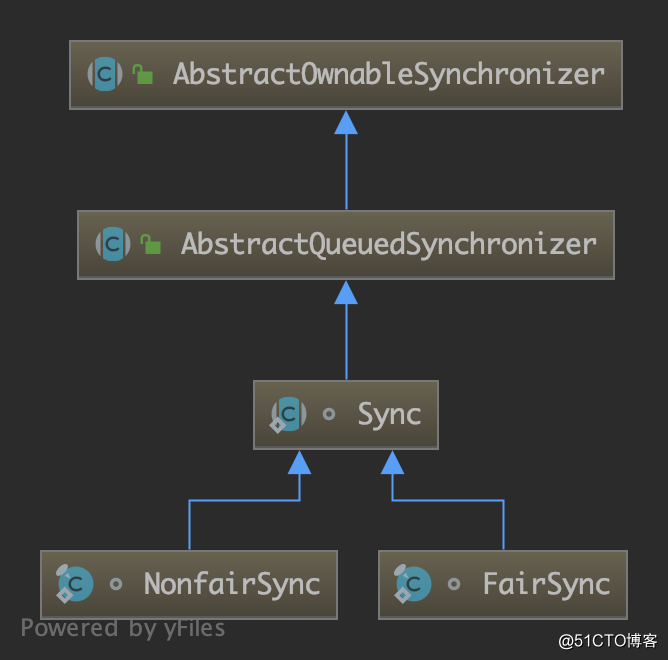标签:blocking 定义 优先级 service 非公平锁 如何 timeout 很多 sleep
概述前面分析过 ReentrantLock「JDK源码分析-ReentrantLock」,它是一种互斥的可重入锁,可用于处理并发场景下的线程安全问题。而很多时候会出现“读多写少”的情况,若用 ReentrantLock 会降低并发量,此时就比较适合 ReentrantReadWriteLock 出场了。
ReentrantReadWriteLock 是读写锁,它维护了一对锁:一个读锁,一个写锁。读锁之间是共享的,写锁是互斥的。与 ReentrantLock 相比,读写锁在读多写少的场景下允许更高的并发量。它的类签名如下:
public class ReentrantReadWriteLock
implements ReadWriteLock, java.io.Serializable {}下面分析其代码实现。
代码分析
ReadWriteLock 接口
ReentrantReadWriteLock 实现了 ReadWriteLock 接口,其代码如下:
public interface ReadWriteLock {
/**
* 返回读锁
*/
Lock readLock();
/**
* 返回写锁
*/
Lock writeLock();
}该接口定义了两个方法,分别返回读锁和写锁,有关 Lock 接口的分析可参考前文「JDK源码分析-Lock&Condition」。
构造器
仍然先从构造器开始分析,如下:
// 无参构造器(默认非公平)
public ReentrantReadWriteLock() {
this(false);
}
// 以给定的公平策略创建一个 ReentrantReadWriteLock 对象
// true 为公平,false 为非公平
public ReentrantReadWriteLock(boolean fair) {
sync = fair ? new FairSync() : new NonfairSync();
readerLock = new ReadLock(this);
writerLock = new WriteLock(this);
}与 ReentrantLock 类似,这里的构造器也传入了公平策略,且默认为非公平。构造器内部初始化了三个变量:sync、readerLock 和 writerLock,如下:
// 提供读锁的内部类
private final ReentrantReadWriteLock.ReadLock readerLock;
// 提供写锁的内部类
private final ReentrantReadWriteLock.WriteLock writerLock;
// 执行所有的同步机制
final Sync sync;下面先分析这几个内部类的代码。
Sync 类
Sync 类继承自 AQS(与 ReentrantLock 中的 Sync 类似),如下:
abstract static class Sync extends AbstractQueuedSynchronizer {
// 使用 AQS 中的 state 变量(int 类型)来记录读写锁的占用情况
// 其中高 16 位记录读锁的持有次数;低 16 位记录写锁的重入次数
static final int SHARED_SHIFT = 16;
static final int SHARED_UNIT = (1 << SHARED_SHIFT);
static final int MAX_COUNT = (1 << SHARED_SHIFT) - 1;
static final int EXCLUSIVE_MASK = (1 << SHARED_SHIFT) - 1;
// 共享锁(读锁)的持有次数
static int sharedCount(int c) { return c >>> SHARED_SHIFT; }
// 互斥锁(写锁)的重入次数
static int exclusiveCount(int c) { return c & EXCLUSIVE_MASK; }
/**
* 每个线程持有读锁的计数器。
* 以 ThreadLocal 形式保存,缓存在 cachedHoldCounter
* 该类的主要作用是记录线程持有读锁的数量,可理解为 <tid,count> 的形式
*/
static final class HoldCounter {
int count = 0;
// Use id, not reference, to avoid garbage retention
final long tid = getThreadId(Thread.currentThread());
}
static final class ThreadLocalHoldCounter
extends ThreadLocal<HoldCounter> {
public HoldCounter initialValue() {
return new HoldCounter();
}
}
/**
* 当前线程持有的可重入读锁的数量(数量为0时删除)。
*/
private transient ThreadLocalHoldCounter readHolds;
private transient HoldCounter cachedHoldCounter;
/**
* firstReader:第一个获取读锁的线程;
* firstReaderHoldCount:firstReader 的持有计数。
*/
private transient Thread firstReader = null;
private transient int firstReaderHoldCount;
Sync() {
readHolds = new ThreadLocalHoldCounter();
setState(getState()); // ensures visibility of readHolds
}
/*
* 对于公平锁和非公平锁,获取和释放锁使用的代码相同;
* 但在队列非空时,它们是否或如何允许插入的方式不同。
*/
/**
* 当前线程在尝试(或有资格)获取读锁时,是否应该由于策略原因而阻塞。
*/
abstract boolean readerShouldBlock();
/**
* 当前线程在尝试(或有资格)获取写锁时,是否应该由于策略原因而阻塞。
*/
abstract boolean writerShouldBlock();
// 释放写锁
protected final boolean tryRelease(int releases) {
if (!isHeldExclusively())
throw new IllegalMonitorStateException();
int nextc = getState() - releases;
boolean free = exclusiveCount(nextc) == 0;
if (free)
setExclusiveOwnerThread(null);
setState(nextc);
return free;
}
// 获取写锁
protected final boolean tryAcquire(int acquires) {
/*
* 流程:
* 1. 若其他线程持有读锁或写锁(计数不为零),返回 false;
* 2. 若持有数量饱和(超出上限),返回 false;
* 3. 该线程有资格获取锁,更新 state 并设置为 owner。
*/
Thread current = Thread.currentThread();
int c = getState();
int w = exclusiveCount(c);
if (c != 0) {
// (Note: if c != 0 and w == 0 then shared count != 0)
if (w == 0 || current != getExclusiveOwnerThread())
return false;
if (w + exclusiveCount(acquires) > MAX_COUNT)
throw new Error("Maximum lock count exceeded");
// Reentrant acquire
setState(c + acquires);
return true;
}
// 若获取写锁时应该阻塞,或者更新 state 失败,返回 false
if (writerShouldBlock() ||
!compareAndSetState(c, c + acquires))
return false;
setExclusiveOwnerThread(current);
return true;
}
// 释放读锁
protected final boolean tryReleaseShared(int unused) {
Thread current = Thread.currentThread();
// 若当前线程是第一个持有读锁的线程
if (firstReader == current) {
// assert firstReaderHoldCount > 0;
if (firstReaderHoldCount == 1)
firstReader = null;
else
firstReaderHoldCount--;
} else {
// 更新缓存
HoldCounter rh = cachedHoldCounter;
if (rh == null || rh.tid != getThreadId(current))
rh = readHolds.get();
int count = rh.count;
if (count <= 1) {
readHolds.remove();
if (count <= 0)
throw unmatchedUnlockException();
}
--rh.count;
}
// 更新 state
for (;;) {
int c = getState();
int nextc = c - SHARED_UNIT;
if (compareAndSetState(c, nextc))
// Releasing the read lock has no effect on readers,
// but it may allow waiting writers to proceed if
// both read and write locks are now free.
return nextc == 0;
}
}
// 获取读锁
protected final int tryAcquireShared(int unused) {
/*
* 流程:
* 1. 如果其他线程持有写锁,获取失败;
* 2. 否则,该线程有资格获取,因此请询问它是否由于队列策略而阻塞;
* 若不阻塞,尝试通过 CAS 更新状态计数。
* 注意:这一步没有检查可重入的获取,推迟到完整版本,
* 以避免在明显不可重入的情况下检查持有计数。
* 3. 如果第二步失败,要么是因为线程明显不符合条件、CAS 失败或计数饱和,
* 则进行完整重试版本。
*/
Thread current = Thread.currentThread();
int c = getState();
// step1. 若写锁被其他线程占用,则获取失败
// exclusiveCount(c) != 0表示写锁被占用
if (exclusiveCount(c) != 0 &&
getExclusiveOwnerThread() != current)
return -1;
// step2. 获取读锁数量
int r = sharedCount(c);
if (!readerShouldBlock() &&
r < MAX_COUNT &&
compareAndSetState(c, c + SHARED_UNIT)) {
// 读锁未被占用,设置该线程是第一个持有读锁的线程
if (r == 0) {
firstReader = current;
firstReaderHoldCount = 1;
// 该线程已持有读锁,计数加1
} else if (firstReader == current) {
firstReaderHoldCount++;
// 其他线程已持有读锁
} else {
// 取缓存
HoldCounter rh = cachedHoldCounter;
// 若未初始化,或者拿到的不是当前线程的计数,则从 ThreadLocal 中获取
if (rh == null || rh.tid != getThreadId(current))
cachedHoldCounter = rh = readHolds.get();
else if (rh.count == 0)
readHolds.set(rh);
// 增加计数
rh.count++;
}
// 获取成功
return 1;
}
// step3. 若step2获取失败,则执行该步骤
return fullTryAcquireShared(current);
}
/**
* 获取读锁的完整版,处理 tryAcquireShared 中未处理的 CAS 丢失和可重入读取。
*/
final int fullTryAcquireShared(Thread current) {
HoldCounter rh = null;
for (;;) {
int c = getState();
// 如果其他线程占用写锁,获取失败
if (exclusiveCount(c) != 0) {
if (getExclusiveOwnerThread() != current)
return -1;
// else we hold the exclusive lock; blocking here
// would cause deadlock.
} else if (readerShouldBlock()) {
// Make sure we‘re not acquiring read lock reentrantly
if (firstReader == current) {
// assert firstReaderHoldCount > 0;
} else {
if (rh == null) {
rh = cachedHoldCounter;
if (rh == null || rh.tid != getThreadId(current)) {
rh = readHolds.get();
if (rh.count == 0)
readHolds.remove();
}
}
if (rh.count == 0)
return -1;
}
}
if (sharedCount(c) == MAX_COUNT)
throw new Error("Maximum lock count exceeded");
if (compareAndSetState(c, c + SHARED_UNIT)) {
if (sharedCount(c) == 0) {
firstReader = current;
firstReaderHoldCount = 1;
} else if (firstReader == current) {
firstReaderHoldCount++;
} else {
if (rh == null)
rh = cachedHoldCounter;
if (rh == null || rh.tid != getThreadId(current))
rh = readHolds.get();
else if (rh.count == 0)
readHolds.set(rh);
rh.count++;
cachedHoldCounter = rh; // cache for release
}
return 1;
}
}
}
/**
* 执行写锁的 tryLock 方法
* 与 tryAcquire 相比,该方法未调用 writerShouldBlock
*/
final boolean tryWriteLock() {
Thread current = Thread.currentThread();
int c = getState();
if (c != 0) {
int w = exclusiveCount(c);
if (w == 0 || current != getExclusiveOwnerThread())
return false;
if (w == MAX_COUNT)
throw new Error("Maximum lock count exceeded");
}
if (!compareAndSetState(c, c + 1))
return false;
setExclusiveOwnerThread(current);
return true;
}
/**
* 执行读锁的 tryLock 方法
* 与 tryAcquireShared 相比,该方法未调用 readerShouldBlock
*/
final boolean tryReadLock() {
Thread current = Thread.currentThread();
for (;;) {
int c = getState();
if (exclusiveCount(c) != 0 &&
getExclusiveOwnerThread() != current)
return false;
int r = sharedCount(c);
if (r == MAX_COUNT)
throw new Error("Maximum lock count exceeded");
if (compareAndSetState(c, c + SHARED_UNIT)) {
if (r == 0) {
firstReader = current;
firstReaderHoldCount = 1;
} else if (firstReader == current) {
firstReaderHoldCount++;
} else {
HoldCounter rh = cachedHoldCounter;
if (rh == null || rh.tid != getThreadId(current))
cachedHoldCounter = rh = readHolds.get();
else if (rh.count == 0)
readHolds.set(rh);
rh.count++;
}
return true;
}
}
}
}Sync 类继承自 AQS,主要重写了 AQS 中独占模式(参考「JDK源码分析-AbstractQueuedSynchronizer(2)」)和共享模式(参考「JDK源码分析-AbstractQueuedSynchronizer(3)」)下获取和释放锁的方法。
Sync 类的继承结构如下:
NonfairSync 类
NonfairSync 继承自 Sync 类,提供非公平策略的实现,如下:
static final class NonfairSync extends Sync {
final boolean writerShouldBlock() {
return false; // writers can always barge
}
final boolean readerShouldBlock() {
// 调用父类 AQS 中的方法实现
return apparentlyFirstQueuedIsExclusive();
}
}
// 若头节点的下一个节点是写线程,为了防止写线程饥饿等待,当前的读线程应该阻塞
final boolean apparentlyFirstQueuedIsExclusive() {
Node h, s;
return (h = head) != null &&
(s = h.next) != null &&
!s.isShared() &&
s.thread != null;
}非公平策略中,writerShouldBlock 返回 false,说明写线程无需阻塞;
readerShouldBlock 则是调用父类 AQS 中的 apparentlyFirstQueuedIsExclusive 方法实现的,该方法通过判断等待队列中的第一个线程是否为写线程,若是则返回 true,表示给写线程让道。
PS: 通过分析这两个方法,发现在非公平策略下,写线程的优先级还是高于读线程的(纯属个人理解)。
FairSync 类
FairSync 也继承自 Sync 类,提供公平策略的实现,如下:
static final class FairSync extends Sync {
final boolean writerShouldBlock() {
return hasQueuedPredecessors();
}
final boolean readerShouldBlock() {
return hasQueuedPredecessors();
}
}在公平策略中,两个方法都通过调用父类 AQS 的 hasQueuedPredecessors 方法判别,二者都是根据等待队列中是否有其他线程,若有其他线程,则当前线程等待。
这就是公平的体现吧:无论读写,都乖乖去排队,别插队。
ReadLock
ReadLock 是读锁的实现,代码如下:
public static class ReadLock implements Lock, java.io.Serializable {
private final Sync sync;
protected ReadLock(ReentrantReadWriteLock lock) {
sync = lock.sync;
}
/**
* 获取读锁(不可中断):
* 1. 若其他线程未持有写锁,则获取读锁并立即返回;
* 2. 若其他线程持有写锁,则由于线程调度,当前线程被禁用并休眠,直到获取读锁。
*/
public void lock() {
sync.acquireShared(1);
}
/**
* 以中断方式获取读锁:
* 1. 若其他线程未持有写锁,则获取读锁并立即返回;
* 2. 若其他线程持有写锁,则由于线程调度,当前线程被禁用并休眠,
* 直到当前获取到读锁,或者被其他线程中断。
*/
public void lockInterruptibly() throws InterruptedException {
sync.acquireSharedInterruptibly(1);
}
/**
* 仅当另一个线程未持有写锁时才能获取读锁。
* 若另一个线程持有写锁,则立即返回 false。
*/
public boolean tryLock() {
return sync.tryReadLock();
}
/**
* 获取读锁(与 tryLock 方法类似,多了超时等待)。
*/
public boolean tryLock(long timeout, TimeUnit unit)
throws InterruptedException {
return sync.tryAcquireSharedNanos(1, unit.toNanos(timeout));
}
/**
* 尝试释放该锁。
* 若读线程的数量为零,则该锁可用于尝试获取写锁。
*/
public void unlock() {
sync.releaseShared(1);
}
public Condition newCondition() {
throw new UnsupportedOperationException();
}
}ReadLock 类实现了 Lock 接口,它的主要方法就是 Lock 接口所定义的方法(获取和释放锁)。读锁之间是共享的,ReadLock 的主要方法都通过 AQS 共享模式的方法实现的。
WriteLock
WriteLock 是写锁,代码如下:
public static class WriteLock implements Lock, java.io.Serializable {
private final Sync sync;
protected WriteLock(ReentrantReadWriteLock lock) {
sync = lock.sync;
}
/**
* 获取写锁。
* 1. 若无其他线程持有读锁或写锁,则获取写锁并立即放回,并将写锁计数设为1;
* 2. 若当前线程已经持有写锁,则将其计数加1,并立即返回(可重入);
* 3. 若锁被其他线程持有,当前线程被禁用并处于休眠状态,直到获取写锁(计数设为1)。
*/
public void lock() {
sync.acquire(1);
}
/**
* 获取写锁(可被中断)。
* 1. 若无其他线程持有读锁或写锁,则获取并立即返回写锁,并将计数设为1;
* 2. 若当前线程已经持有写锁,则将其计数加1,并立即返回(可重入);
* 3. 若锁被其他线程持有,当前线程被禁用并处于休眠状态,
* 直到当前线程获取写锁(计数设为1)或被其他线程中断。
*/
public void lockInterruptibly() throws InterruptedException {
sync.acquireInterruptibly(1);
}
/**
* 仅当调用时其他线程未持有该写锁时,才获取该写锁。
*/
public boolean tryLock( ) {
return sync.tryWriteLock();
}
/**
* 尝试获取写锁(响应中断,有超时等待)。
*/
public boolean tryLock(long timeout, TimeUnit unit)
throws InterruptedException {
return sync.tryAcquireNanos(1, unit.toNanos(timeout));
}
/**
* 尝试释放锁。
* 若当前线程是锁的持有者,则持有计数将减少;若当前持有计数为零则释放锁。
* 若当前线程不是锁的持有者,则抛出异常IllegalMonitorStateException
*/
public void unlock() {
sync.release(1);
}
public Condition newCondition() {
return sync.newCondition();
}
/**
* 查询此写锁是否由当前线程持有。
*/
public boolean isHeldByCurrentThread() {
return sync.isHeldExclusively();
}
/**
* 查询当前线程对该写锁的持有计数。
*/
public int getHoldCount() {
return sync.getWriteHoldCount();
}
}与 ReadLock 类似,WriteLock 类也实现了 Lock 接口,其主要方法也是 Lock 接口所定义的方法(获取和释放锁)。而写锁是互斥的,WriteLock 的大部分方法都是通过 AQS 独占模式的方法实现的。
ReentrantReadWriteLock 的主要代码就分析到这里,下面简单分析其用法和使用场景。
示例代码
为便于理解读写锁的操作,下面举个栗子验证(代码仅供参考):
public class TestRDLock {
// 创建一个线程池
private static ExecutorService threadPoolExecutor = new ThreadPoolExecutor(10, 20,
60, TimeUnit.SECONDS, new ArrayBlockingQueue<>(100));
// 创建一个读写锁实例
private static final ReadWriteLock readWriteLock = new ReentrantReadWriteLock();
public static void main(String[] args) {
for (int i = 0; i < 5; i++) {
// 这里可以尝试“读读“、“读写”和“写写”场景的代码测试(仅供参考)
threadPoolExecutor.execute(new ReadTask());
threadPoolExecutor.execute(new WriteTask());
}
}
// 写操作
private static class WriteTask implements Runnable {
@Override
public void run() {
readWriteLock.writeLock().lock();
try {
System.out.println(Thread.currentThread().getName() + " 获取写锁");
TimeUnit.SECONDS.sleep(5);
} catch (InterruptedException e) {
e.printStackTrace();
} finally {
readWriteLock.writeLock().unlock();
System.out.println(Thread.currentThread().getName() + " 释放了写锁");
}
}
}
// 读操作
private static class ReadTask implements Runnable {
@Override
public void run() {
readWriteLock.readLock().lock();
try {
System.out.println(Thread.currentThread().getName() + " 获取读锁");
TimeUnit.SECONDS.sleep(5);
} catch (InterruptedException e) {
e.printStackTrace();
} finally {
readWriteLock.readLock().unlock();
System.out.println(Thread.currentThread().getName() + " 释放了读锁");
}
}
}
}Java API 文档中还提供了两个典型的使用场景,如下:
class CachedData {
Object data;
volatile boolean cacheValid;
final ReentrantReadWriteLock rwl = new ReentrantReadWriteLock();
void processCachedData() {
// 先获取读锁
rwl.readLock().lock();
if (!cacheValid) {
// Must release read lock before acquiring write lock
rwl.readLock().unlock();
rwl.writeLock().lock();
try {
// Recheck state because another thread might have
// acquired write lock and changed state before we did.
// 更新缓存(持有写锁的情况下)
if (!cacheValid) {
data = ...
cacheValid = true;
}
// Downgrade by acquiring read lock before releasing write lock
rwl.readLock().lock();
} finally {
// 释放写锁(仍然持有读锁,即降级为读锁)
rwl.writeLock().unlock(); // Unlock write, still hold read
}
}
try {
use(data);
} finally {
// 释放读锁
rwl.readLock().unlock();
}
}
}class RWDictionary {
private final Map<String, Data> m = new TreeMap<String, Data>();
private final ReentrantReadWriteLock rwl = new ReentrantReadWriteLock();
private final Lock r = rwl.readLock();
private final Lock w = rwl.writeLock();
public Data get(String key) {
r.lock();
try { return m.get(key); }
finally { r.unlock(); }
}
public String[] allKeys() {
r.lock();
try { return m.keySet().toArray(); }
finally { r.unlock(); }
}
public Data put(String key, Data value) {
w.lock();
try { return m.put(key, value); }
finally { w.unlock(); }
}
public void clear() {
w.lock();
try { m.clear(); }
finally { w.unlock(); }
}
}参考:

JDK源码分析-ReentrantReadWriteLock
标签:blocking 定义 优先级 service 非公平锁 如何 timeout 很多 sleep
原文地址:https://blog.51cto.com/14901361/2523633